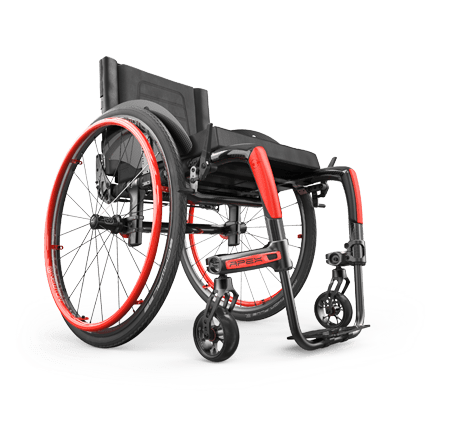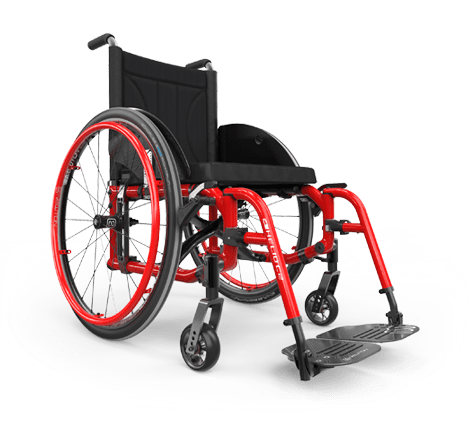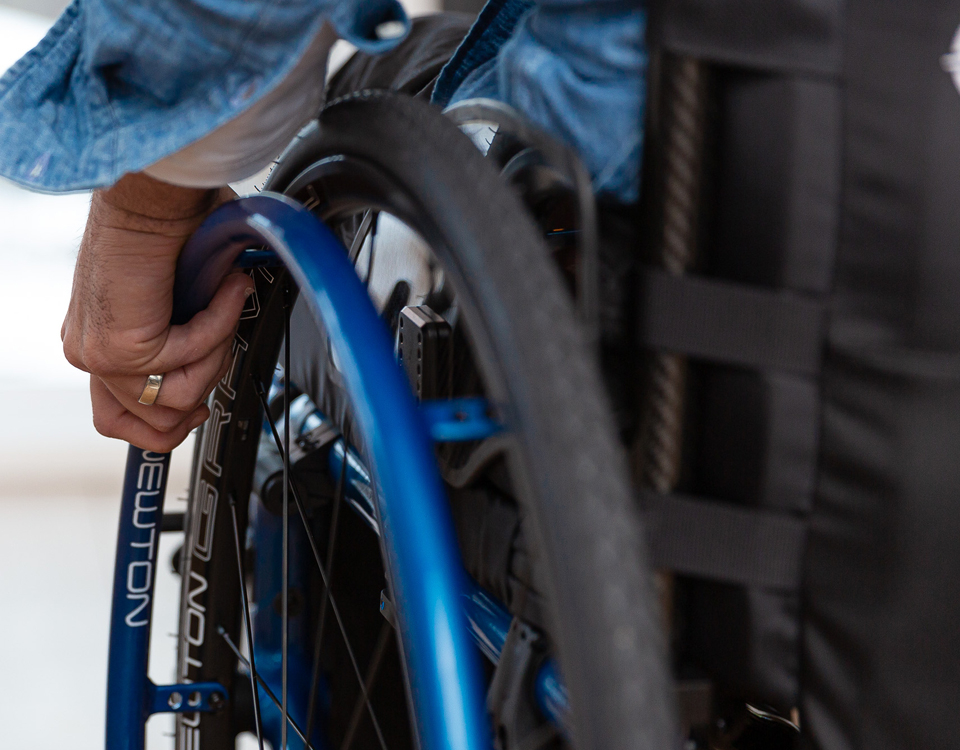Manually propelling a wheelchair is an activity which has low mechanical efficiency; the energy put into propulsion is not proportional to the movement of the wheelchair and an active wheelchair user will push their handrims 2000-3000 times per day. Due to these factors upper extremity repetitive strain injuries are common for manual wheelchair users. Recent research suggests the way in which a user propels his or her wheelchair overtime can cause of pain and injury of the upper extremity, especially in the shoulders and wrists. Specifically, the high-force and high-repetition from manual propulsion can cause damage to the median nerve of the wrist causing carpal tunnel syndrome.
With as much interaction as the user has with the handrim, we need to make sure they are given ample consideration during the prescription process. Matching the handrim to the user can increase propulsion efficiency and effectively prevent upper extremity injuries. If upper extremity conditions already exist changing features of the handrim can help to reduce pain or the likelihood of further the injury. Here will review handrim features which can help us understand how to customize a handrim to the user.
Material
Anodized Aluminum: Anodization seals the rim to prevent oxidization. This is the most common standard handrim for a manual wheelchair and is a good balance between lightweight and function. A silver matte finish is most common but black hard anodized rims are becoming more popular.
Stainless Steel: Stainless handrims are a choice in many places due to the durability and lack of heat transfer. They stay cool and easy to use even in extreme temperatures. They may also have an embossed texture for better control.
Titanium: Known for their lightweight and durability. You are able to buff out scratches and often have a selection of matte or polished finish. However, they may cause reactions with the skin for some people.
Wood: in the past few years, wood handrims have started to make a comeback. While they may seem old fashioned to some, the technology used to make wooden handrims allows the manufacturing of rims that are smooth (no splinters) and don’t react to temperature changes. They are water repellent and have a particular aesthetic.
High friction: Adding a high-friction material, such as plastic, vinyl or neoprene, overtop of an aluminum handrim can increase the grip a user has allowing a higher energy transfer. This can aid in propulsion for those who may not have full hand function or strength. Due to the higher friction from a coated handrim this can cause burning on the user’s hands when turning, stopping or going downhill at higher speeds. Also, how the material is affixed to the metal handrim can affect its durability. Coated handrims can tear and sometimes be abrasive on the user’s hands or completely peel off decreasing its effectiveness. Look for handrims that are dipped, or painted rather than glued in place for improved durability.
Combination: As opposed to applying a high-friction material to the whole handrim it can be applied to just a strip along the top surface of the handrim. This allows for increased friction for grip during propulsion and leaves the sides smooth for braking. These are intended to provide better control for users with normal hand function.
Shape
Shape is another feature of handrims which can affect how the user grips the handrim and in what position their hand makes contact. A round handrim is the more traditional shape,but due to its smaller size it can force the user into a pinch grasp causing more extreme hand and wrist range of motion. Repetitive, extreme range of motion at the wrist can increase pressure within the carpal tunnel and overtime can cause carpal tunnel syndrome. To compensate for this, some users will grab the tire along with the handrim which opens the hand and decreases the pinch grasp, but neither the tire or handrim was designed to be used in this manner.
Handrims have been designed with an ergonomic or oval shape to allow for more surface area for gripping and a more ergonomic wrist position; this larger surface area eliminates the need for the pinch grasp. Many ergonomic handrims such as Natural-Fit and Flexrim have been studied and proven to decrease symptoms of wrist and hand injury.
Diameter
Handrim diameter can vary from 20mm to upwards of 50mm. The diameter can directly affect how a user grips the handrim and in what position their hand makes contact. Larger diameters can assist a user with limited grasping ability and may benefit younger users with smaller hands.
Spacing
Some handrims allow variation in the spacing from the wheel/tire. This can assist with hand positioning to ensure a proper grip is secured for maximum contact. This can also be customized to ensure the overall width is not too wide for the user’s environment.

Hand rims may be a small component on the wheelchair, but they have a big impact on how the user propels. The details of size, shape and materials can allow the client to maximize their energy transfer and therefore efficiency. Pay attention to these details and match the features to the user and you will get the most out of every push!
References
- Boninger ML, Souza A, Cooper RA, Fitzgerald SG, Koontz A, Fay B. Propulsion Patterns and Pushrim Biomechanics in Manual Wheelchair Propulsion. Archives of Physical Medicine & Rehabilitation, 2002, 83(5): 718-723.
- Boninger ML, Impink B, Cooper RA, Koontz AM, Relation Between Median and Ulnar Nerve Function and Wrist Kinematics During Wheelchair Propulsion, Archives of Physical Medicine and Rehabilitation, Vol. 85, No. 7, pp. 1141-1145, July 2004.
- Koontz, A., Yang, Y., Boninger, D., Kanaly, J., Cooper, R., Boninger, M., Dieruf, K., & Ewer, L. (2006). Investigation of the Performance of an Ergonomic Handrim as a Pain-Relieving Intervention for Manual Wheelchair Users. Assistive Technology, 18(2), 123–145. https://doi.org/10.1080/10400435.2006.10131912
- Rice I, Impink B, Niyonkuru C, Boninger ML, Manual Wheelchair Stroke Characteristics During an Extended Period of Propulsion, Spinal Cord, pp. 413-417, Vol. 47, No. 5, May 2009.
- van der Linden ML, Valent L, Veeger HE, van der Woude LH. The effect of wheelchair handrim tube diameter on propulsion efficiency and force application (tube diameter and efficiency in wheelchairs), IEEE Trans Rehab Engr 1996; 4(3):123-32.








